By Linda Williams, DNR Forest Health Specialist, Woodruff; Linda.Williams@wisconsin.gov or 920-360-0665
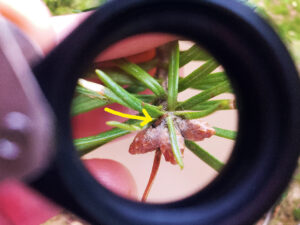
Spruce budworm overwinters as tiny caterpillars (yellow arrow) that migrate to the buds before they start to swell in the spring. A magnifying lens is needed to see them at this stage. / Photo Credit: Linda Williams, Wisconsin DNR.
For the 11th consecutive year in Wisconsin, spruce budworm has caused significant defoliation on spruce, balsam fir and tamarack in some areas of the state.
This year, areas with widespread severe defoliation include Oneida and Vilas counties, with Forest, Iron, and Langlade counties also showing significant defoliation.
In areas with severe defoliation, all the new needles were consumed by caterpillars, and even the new twigs were destroyed, leaving only bud scales, webbing and a few pieces of brown needles.
One new aspect of the budworm defoliation this year is tamarack defoliation. This defoliation has not been noted previously but often results in nearly 100% defoliation of tamarack trees, with webbing completely covering branches. Defoliated tamarack are typically found growing near balsam fir that is also being defoliated.
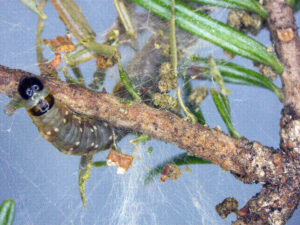
A spruce budworm caterpillar on a balsam fir branch, with needles and frass mixed in with its webbing. / Photo Credit: Linda Williams, Wisconsin DNR.
Caterpillars started turning into pupae in Oneida County on June 12; pupation was complete in Langlade County by June 15. Moths begin to emerge within 10 days of pupation to mate and lay eggs. In areas with severe defoliation, hundreds of moths fluttered around each balsam fir or spruce tree in late June. There is only one generation per year, so defoliation is done for this year.
Spruce budworm is a native insect that has periodic outbreaks in the Midwest. Outbreaks occur every 30-50 years, and each bout lasts an average of 10 years. Our previous outbreak ran from 1970-1980, and our current outbreak began approximately in 2012. Unfortunately, populations are still going strong, and we are unsure when they will collapse again. Whether climate change plays a role in outbreak duration is unknown.
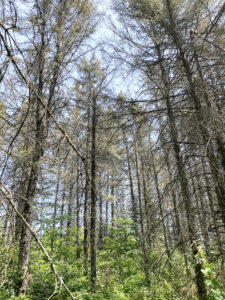
A white spruce plantation shows severe defoliation due to spruce budworm infestation, with no new foliage remaining. Only old needles remain. / Photo Credit: Linda Williams, Wisconsin DNR.
Mature balsam fir and spruce are preferred hosts, although younger trees are also defoliated. Repeated defoliation causes top mortality and eventually whole-tree mortality. Balsam fir stands or stands with a heavy component of balsam fir are often more severely impacted.
Forest managers should monitor balsam fir, and spruce stands for signs of repeated defoliation and top kill or whole-tree mortality. After three years of significant or additional years of lighter defoliation, you may see dieback in the tops of trees. If trees are missing more than 75% of their needles or the stand has been heavily defoliated for over three years (including the current year), foresters should consider salvage harvests to capture value from affected trees before they die.
Homeowners with just a few spruce or fir trees to protect can treat them with insecticide. The biological insecticide Btk (Bacillus thuringiensis var. kurstaki) and general insecticides will work on the caterpillars. Defoliation is often most severe in the upper portions of the tree, so homeowners should plan accordingly to ensure the entire tree is treated. Certified arborists often have equipment that can reach the tops of trees. Treatments must be done early in the spring when the caterpillars are still small. When you see the rusty red color in the trees, the caterpillar damage has already been done, and spraying will not be effective.
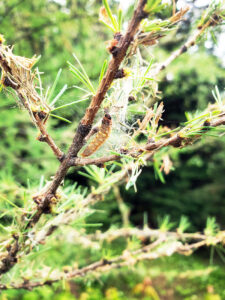
A spruce budworm caterpillar feeding on tamarack. / Photo Credit: Linda Williams, Wisconsin DNR.
In areas with severe defoliation this year, expect high populations again next year. In these areas, if landowners want to spray with Btk it should be done just as buds are breaking in the spring (when you can start to see the needles emerging) and may need to be repeated 10 days to two weeks later.
Spruce budworm overwinters as a tiny caterpillar and makes its way to the branch tips early in the spring before the buds break, so as soon as the buds break, they can start feeding on the tender new foliage. In areas with very high populations, the caterpillars may even chew their way into the enlarging bud to feed on delicate new foliage before it can expand.
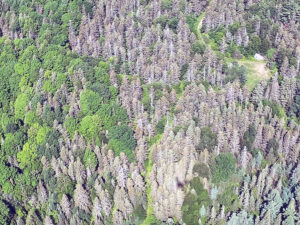
The result of spruce budworm defoliation viewed from the air. Trees appear grey or brown due to defoliation, allowing branches to show through. / Photo Credit: Linda Williams, Wisconsin DNR.
